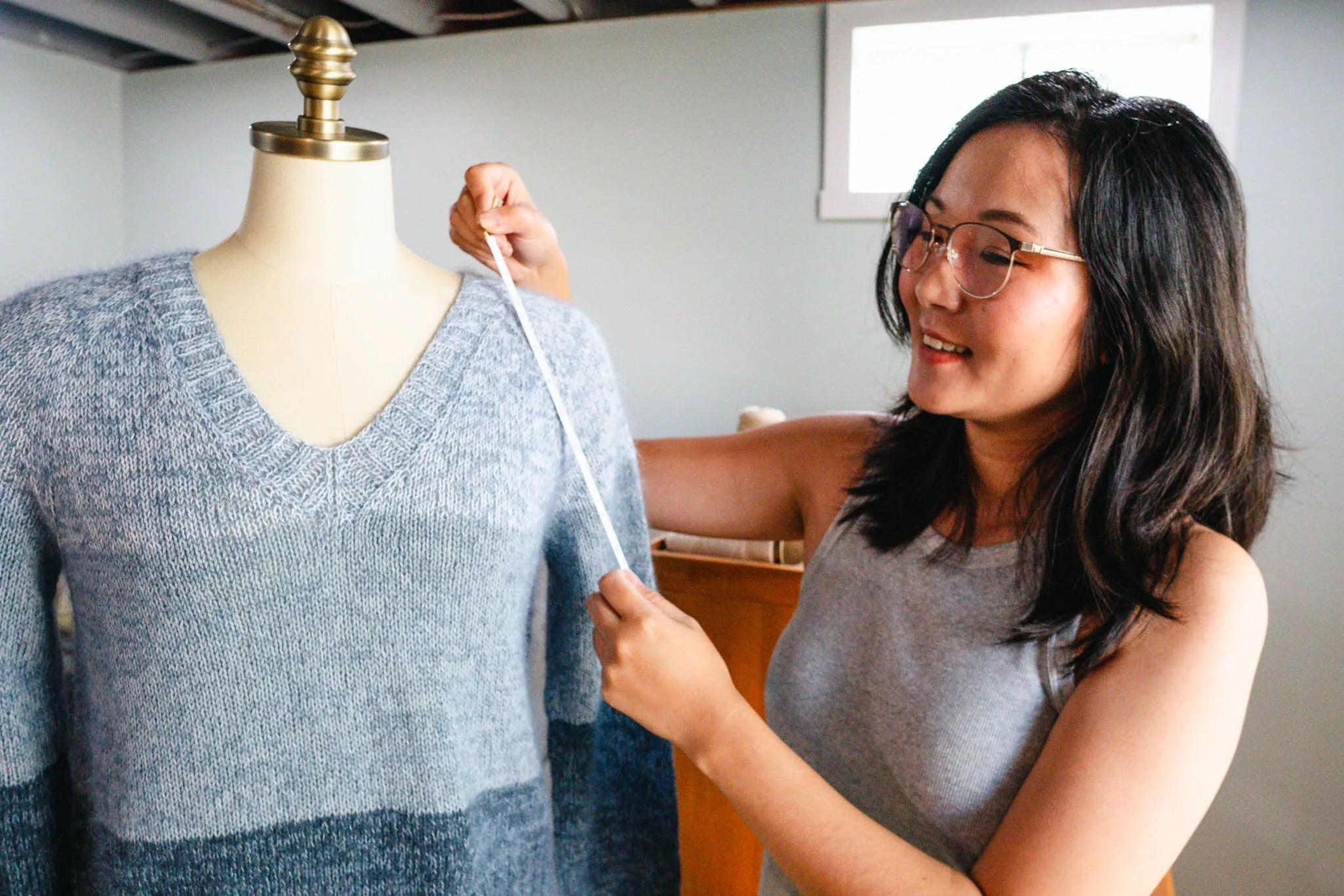
Raglan depth vs armhole depth for sweater knitting
For many knitters, their first sweater patterns often feature raglan construction. The raglan pullover is often seen as an easy beginner knit. However, some of the measurements that raglan sweaters have can be really confounding and opaque, making it difficult to modify.
Often times, we confuse raglan depth or length with armhole depth. However, they are not the same thing!
Today, let's talk through some of the key measurements in raglans, particularly in the lengths. We'll go over how to measure and calculate raglan depth. Then, we'll talk about how raglan depth relates to the overall garment measurements.
By the way, you'll find that I use raglan depth and raglan length pretty interchangeably in this article. Sometimes, this is also referred to as a yoke depth.

The pattern featured in this photo is a top-down raglan compound construction pattern by me, the Hibernate Pullover, coming September 24, 2024.
Why do we care about accurate length calculations?
Designers today, including myself, have been writing a glut of top-down sweaters. These projects can be tried on easily as you work, but often times this is no guarantee for a good fit.
Plus, some patterns do much, much better bottom up, and with seams. For example, if the patterning features heavy cables, they really benefit from seams to hold up all that weight. Or, if a pattern is worked up in summer yarns with no structure or crimp, such as silk, they might also benefit from seams.
Read more about seams in summer garments.
Additionally, it's often easier to decrease in pattern than increase in the stitch pattern. So, for patterned garments, we'll end up with a simpler, more elegant pattern if we write bottom up. This results in a pattern that is easier to use than the same pattern written top-down.
Even if you plan to knit top down, there are situations where you'll want to know the details of your raglan depth before you cast on. This is because it may be too late to make changes by the time you have enough sweater to try on!
Why raglan depth is useful in modifications
You'll want to know how to calculate for some of these elements and understand how they impact fit. For example, a common modification is in the raglan length.
If you are taller than the average 5'5"-5'6" / 165-170 cm or so, you may need to lengthen your raglan line. This will extend the armhole so that it fits your taller upper torso. If you are shorter than average, you might want to do the opposite.
A too-short raglan depth will be tight and uncomfortable, while a too-long raglan depth will create a lot of extra fabric. Not only is that bulky, it also means when you lift your arms, the whole garment is gonna come up with it.
And the best place to make these kinds of modifications totally depends on knowing what this armhole measurement is going to be ahead of time.
If you are making a mod like lengthening your raglan depth, you must shorten the body accordingly unless you want an overall longer garment. And the way you'll find out whether you want this or not is to compare your pattern's total garment length with garments you already wear!
Now that we've covered situations where you'll want to get into the weeds with the length or depth of raglans, let's talk about the body measurements that this measurement covers.
Body measurements contained in a raglan depth
If we were working set-in sleeves, we'd measure and calculate garments for shoulder depth and the armhole depth measurements separately.
However, because the sleeve line for the raglan is at the neck, we need to take into consideration both the shoulder drop and the worked raglan rows. The best way to calculate the raglan depth is to add the armhole depth to the shoulder drop depth when assessing a pattern.

The shoulder drop is typically 1.63" / 4.1 cm across the size range on the size chart that I and many designers use (shown in green below).
If you need help finding these measurements, check out my guide on how to measure armhole depth with a tape measure.
Added together, the armhole depth and shoulder drop create the measurement that the armhole depth or raglan depth should cover in a raglan construction.
Sometimes you'll have no ease or negative ease in this area, but more often than not designers will grade this area with positive ease. I prefer at least 1" / 2.5 cm myself for comfort and room to move around.
So, to summarize, the raglan depth measurement is gonna cover:
Armhole depth + shoulder drop + wearing ease = raglan depth.
Actual measurements in raglan depth
So now that we know the body measurements that are covered by the raglan depth, let's talk through the elements in the raglan knitting pattern that will make up the raglan depth.
Many knitters and designers, including myself in some past patterns, misconstrue the raglan length measurement as the same thing as armhole depth. However, they are not the same thing at all.

I commonly see, including in a few of my earliest raglan patterns, designers and knitters talking only about the raglan depth/length or raglan lines, meaning, the number of raglan rows divided by the row gauge per inch. You can see in the photo above how I often see knitters measure their raglan depths, along a diagonal line, which is not accurate!
But this won't accurately help you understand the fit of your actual armhole. If a pattern schematic does not give you a raglan depth, here's how you'll find out what the depth is:
What we think of as an armhole depth (remember, in a raglan this will include the shoulder drop) is actually going to be measured differently than the raglan depth, because in many raglan construction patterns, the top of the shoulder, or where a shoulder seam would have been, is not at the top of the raglan line. The top of your raglan sleeves must be taken into consideration.
About 1/2 of the top of your sleeve will be showing, so you need to take your measurement from the top of the shoulder, at the neck edge. To calculate this before you work it, take 1/2 of the top of sleeve cast on, and divide that by the stitches per 1 inch of your gauge (red, below).
This, combined with your actual worked raglan yoke length (or number of rows/rounds before sleeve divide, divided by the rows per inch), is the actual armhole depth (including shoulder drop) in a raglan garment. You can see that this measurement is actually a straight line straight down. This whole thing can have a very different measurement than if you measured just the raglan section on the diagonal!
And if you are measuring along the diagonal which is stretched out, and not the straight parallel, you'll end up with a large difference between the two methods of measurement. Moreover, the diagonal measurement won't correspond to your armhole measurement accurately and won't help you determine fit.
The formula for raglan depth

So, when we combine everything we have talked about in this article, the formula for raglan construction armhole depths is as follows:
Worked raglan length + 1/2 shoulder cast on width = raglan depth = armhole depth + shoulder drop + wearing ease
With this information in hand, you can make any modifications you'd like, including lengthening or shortening the raglan length to your preferred length. This will involve changing the rate of raglan increases throughout the yoke.
The next step: how to use this information
You can definitely do so by trial and error, but now you also know how to measure your favorite raglan sweaters for their proper raglan depth measurement and then work your new sweater to match.
Additionally, many tall or petite people need to make length adjustments in not just the body, but in the raglan to fit their torso. This information is particularly helpful for tall people, who will need enough room to move around.
Finally, this measurement will really help you assess patterns. The recommended ease in the underarm area is never given in the patterns, but it's helpful to know what it is so that you can determine if it's a good fit for you. This can also help you avoid patterns that are poorly graded with an armpit all the way out where the waist is, a common occurrence in top-down sweaters with traditional raglan construction.
Total garment length in raglan
When you make an adjustment in this area, remember you'll be changing the overall garment length also.
If you shorten the raglan line, you'll need to increase the body length accordingly to maintain the same raglan body length.
I know many knitters who knit to a pre-determined body length, but depending on the raglan depth and whether it was graded to fit closely to the body or with more of an oversized fit, the body length will change wildly, and thus cannot be relied on to get the sweater length you want.
How do we get a better idea of how long to knit the body?
By understanding total garment length! The total garment length will be the equation we talked about above, with the raglan depth + 1/2 of the top of sleeve, plus the body length.

When you have these exact measurements in hand, it's much easier to see what the overall garment length will be, and how these measurements relate to each other.
And finally, if you are being asked to knit until garment measures, for example, 8 inches before changing colors (actual instruction from the pattern pictured here), you're now armed with the information you need to make that measurement accurately, as the raglan depth will impact this too.
I hope that this article has been helpful and that you have found a little bit of information to help you get a better fit on your sweater patterns. I'm committed to creating patterns for all kinds of body shapes, but no one truly fits into a size chart perfectly.
If you are looking for more articles on getting a better fit, check out our resources on sweater fit, with some specifically focused on raglan:




2 comments
This is a wonderful discussion! My husband is 6’3 and built like a truck. Many patterns are not made for men that tall or they assume similar proportions to shorter men, which can lead to weirdness in the measurements, so I’ve always designed my own sweaters for him (A lopi style and an aran style so far!) While I’ve knit several raglan sweaters, I’ve always depended on a pattern, but I couldn’t find any to fit him, so I’m creating my own. This discussion really helped me understand how to plan out the sleeves and the raglan seam!
Pamela Taylor
These instructions for raglan depth/length are really outstanding. Very concise and easy to understand with your excellent illustration! Thankyou! Very helpful!
Anna Bryan
Leave a comment
This site is protected by hCaptcha and the hCaptcha Privacy Policy and Terms of Service apply.